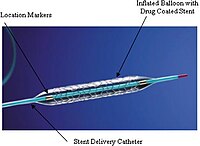
Photo from wikipedia
After the introduction of drug eluting stent (DES) the rate of in‐stent restenosis (ISR) has decreased if compared to the BMS era; however, treatment of patients with ISR remained a… Click to show full abstract
After the introduction of drug eluting stent (DES) the rate of in‐stent restenosis (ISR) has decreased if compared to the BMS era; however, treatment of patients with ISR remained a major issue for the interventional cardiologist. DES has been largely used with good results also as second layer for the treatment of ISR, but the overall percentage of patients suffering from restenosis still remains high, especially in some subgroups of patients as ones with diabetes mellitus (DM). In this clinical scenario, drug coated balloon (DCB) has been gaining an important role for the treatment of ISR. In fact, it allows to release an antiproliferative drug, namely paclitaxel, without the addition of a second metallic strut, which can lead to a persistent inflammatory stimulus and further narrow the vessel. This could be an advantage in patients with an already increased systemic inflammatory burden and stiffer vessels as those with DM. Despite differences in terms of efficacy and safety between DES and DCB have already been evaluated in different clinical trials, just few of these focused on diabetic patients. The aim of this paper is to review the available data for treatment of ISR both with DES, DCB, and a comparison between these two devices, in patients affected by DM. © 2017 Wiley Periodicals, Inc.
Journal Title: Catheterization and Cardiovascular Interventions
Year Published: 2018
Link to full text (if available)
Share on Social Media: Sign Up to like & get
recommendations!